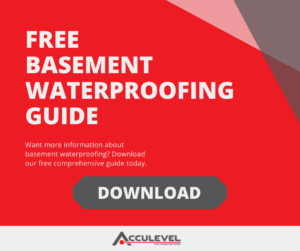How Does Water Damage My Foundation?

Many homeowners install water drainage in their basements to prevent leaks or flooding. This is reasonable and logical; a damp basement encourages mold, damages anything stored there, and makes a soggy mess.
But the water outside your home isn’t just trying to cause flooding. It’s also damaging your foundation in ways that are more subtle than puddles on a basement floor.
Acculevel is a family-owned and operated company that specializes in waterproofing and foundation repair. Since our start in 1996, we’ve helped more than 35,000 homeowners repair their homes, restoring their stability, health and resale value. We focus on providing a whole-home solution for each homeowner we meet. Our goal is to address both the symptoms you’ve noticed and their underlying causes.
In this article, we’re going to examine the two most common underlying causes for foundation damage: erosion and hydrostatic pressure.
Before we begin: if you haven’t identified the soil in your yard, you may want to go outside and perform a quick test. Scoop out a handful of wet dirt. If it crumbles or breaks apart easily, it’s more granular. If the dirt packs together, it has more clay in it, making it expansive soil.
Erosion Is More Common In Granular Soil
Granular soil, as the name suggests, has more individual “grains” in it. This type of soil is usually a mixture of loam, sand, gravel, and silt.
Because granular soil does not pack tightly together, water can move through it more easily. This means it drains more quickly, which can be good. But it also means it can move around your home more rapidly and it can take portions of your soil with it. This is how erosion occurs around- and under- your home’s foundation.
How Does Erosion Damage Your Foundation?
When your house was newly built, it settled in small increments over the first few years. This is because the weight of your home changed, once it was full of furniture, appliances, people walking around, etc. This settling is normal and didn’t cause much of an issue, because the entire building was settling at an even pace.
Erosion, on the other hand, does not distribute itself evenly across your house. This means portions of your home may be settling faster or slower than the others. Uneven settling causes gradual and significant strain on your house’s structure.

This photo was taken by an Acculevel project advisor during a free home assessment. This three season room is settling and pulling away from the rest of the house.
Your home’s structure is not flexible. You don’t want it to be! All the building components -concrete, wood, steel, brick, drywall- are meant to be rigid and unbending. That’s what gives your home strength and stability. So when one section or corner sinks deeper than the rest, that section pulls at the rest of the home.
What Are Signs Your Foundation is Settling Unevenly?
Your foundation is where the problem starts, but homeowners often notice the problems on the main floor first:
- All of the framework is strained, and the wooden timbers will start to warp or shift. This will show up in door and window frames. In the photo above, you can see the sliding door has come off-track.
- This probably began with the door “sticking,” making it hard to open or close. Windows and doors are often the first sign of a problem. Do you have windows that won’t stay open without a prop? Maybe doors won’t stay closed unless they’re locked?
- The drywall is also under stress, but it’s not as strong as the lumber in your home’s frame. This means it will crack as the framework shifts.
- Drywall cracks can happen anywhere, but when your foundation is settling unevenly, the most obvious places will be near the sticking windows or doors.
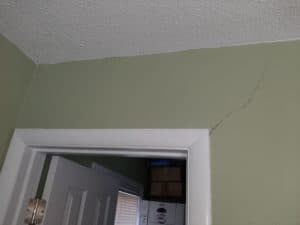
This photo was also taken by an Acculevel project advisor during an in-home assessment. This door is sticking and the drywall has cracked at the corner.
There are some signs of settling that can be found on the outside of your home, also. If you suspect a certain portion of your home is settling too quickly, you can look at the outside of the area in question. Cracks or gaps in the exterior walls are a common sign.
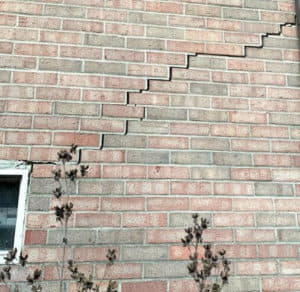
Another photo by an Acculevel project advisor, taken during a home assessment. This crack on the outside also starts at the window, moving towards the outside wall.
How Do You Repair A Foundation That Is Settling Unevenly?
The first priority is going to be stabilizing your foundation. You need to stop the eroded foundation from sinking any farther, and creating more damage. You may also want to lift the “stray foundation” back into its original position, but this isn’t always possible.
Your foundation didn’t settle overnight, and look at the damage it’s done. Your home’s structure has had years of slow, gradual change. Now imagine how much chaos it would create if you forced it to move back up in a few minutes. Remember- your structure isn’t flexible, so it’s not going to just “bounce back.”
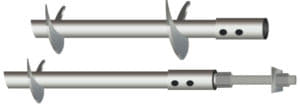
This is an illustration of helical pier sections.
You Need Helical Piers
Helical piers are the ideal repair method for stabilizing an uneven foundation. These are steel posts with screw-like blades attached to them. This structure allows them to be screwed down into the earth next to the foundation, until they read the necessary depth to hold fast. (The depth required is measured by a pressure gauge attached to the drilling equipment.
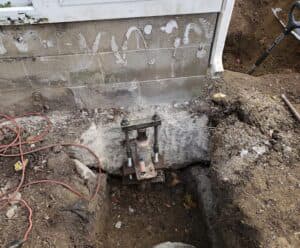
This photo was taken by an Acculevel crew member, during pier installation. This is the same three-season room we showed earlier in this section.
The piers are attached to the sinking part of the foundation, but only after the necessary depth is achieved. Done properly, this repair should be permanent; Acculevel warranties pier installations for the life of your home’s structure.
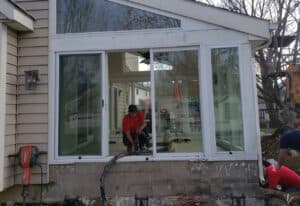
Another photo of the three-season room, after piers were installed. You can see the door track is now level and the gap under the track has been closed. Remember: lift is not guaranteed, but in this instance, it was possible.
If you have more questions about helical piers, this article explores how they work in greater detail.
But if you haven’t seen any signs of uneven settling? Or if you don’t have granular soil? Then it’s likely that you need to be reading the next section…
Hydrostatic Pressure Is More Common In Expansive Soil
As you may have guessed, expansive soil packs together much better than granular soil. This is because it has a much higher clay content. When it rains, expansive soil absorbs water more slowly, holds onto it longer, and releases it just as slowly.
This means that the water doesn’t flow quickly through the earth (like it does with erosion). Instead, it lingers in the soil. When the soil is fully saturated, any extra water keeps moving around until it runs into something it can’t move. Sometimes this obstacle is a dam, a drainage trench, or other method of water management. Unfortunately, sometimes it’s your home’s foundation in the way.
Excess water pushing against your foundation is called hydrostatic pressure.
How Does Hydrostatic Pressure Harm Your Foundation?
It may sound insignificant to you- I mean, it’s just water! But here are few facts you have to remember:
- Concrete is a porous material. Water can seep into -and through- your foundation. Over time, this water will “eat away” at the concrete until it cracks.
- Cracks in your foundation weaken its stability. (They also let larger/more frequent amounts of water into your basement.)
- Houses are not built to resist pressure from the side. Your foundation’s primary function is to support the structure built on top of it.
Essentially, your home’s foundation isn’t designed to resist the hydrostatic pressure, so it is susceptible to damage.
What Are Signs of Hydrostatic Pressure In Your Basement?
You obviously want to repair any cracks that allow water into your basement, but there are specific types of cracks that should be a cause for greater alarm.
- If you have a poured concrete foundation, you need to be on the lookout for long horizontal cracks.
- Homes with concrete block formations need to watch for these horizontal cracks. But they can also develop cracks shaped in a zig-zag pattern that look like stair steps. This is because the cracks follow along the mortar lines between the blocks.
- If there are any signs a basement wall is leaning or bowing inward, you need to act now.

This photo was taken by an Acculevel project advisor during an in-home assessment. Both types of hydrostatic pressure cracks are visible in this basement wall.
How Do You Repair A Foundation Wall Damaged by Hydrostatic Pressure?
There are a few different repair methods available for badly cracked or bowing walls. The deciding factor is usually the severity of the foundation damage. All of the repair methods that Acculevel offers for bowing walls are warrantied for the life of your structure. It is in your best interests to take action as soon as you notice a problem.
Is Your Foundation Badly Cracked or Bowing Less Than 3 inches?
The best repair option for a basement wall that has been damaged by hydrostatic pressure is carbon fiber straps. This is the best repair method for several reasons:
- They are the least invasive. There’s no excavation required in your yard, minimal mess, and the entire installation can be done from inside your basement.
- Carbon fiber straps are the least expensive repair option, but they are only effective on walls that have bowed less than 3 inches.
- The other two repair methods require drilling holes through your foundation wall.
- Once the installation has completely cured and dried, you can paint over the straps to minimize their appearance.
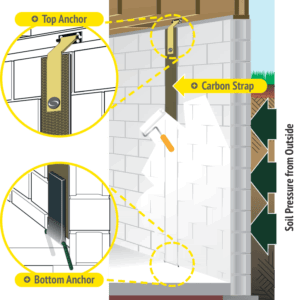
This is an illustration of how carbon fiber straps are installed.
Is Your Foundation Wall Bowing More Than 3 Inches?
There are two options for repairing a severely bowing wall: wall anchors and helical tiebacks. Both of them are effective, warrantied for the life of the structure, and require drilling holes through your foundation.
Wall Anchors Require Excavation
Wall anchors are less expensive than helical tiebacks, but they also require room for excavation. A large steel plate is buried in the yard (approximately 10 feet from the damaged wall). This “anchor” is used to secure the steel post that is drilled through your foundation wall out to the anchor plate.
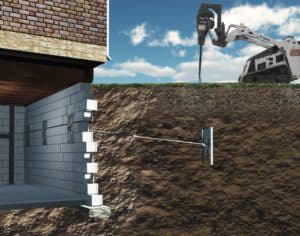
This is an illustration of a wall anchor installation.
Sometimes a home is not well situated for wall anchors. Maybe 10 feet away from your bowing basement wall crosses the property line into your neighbor’s yard. Or it will cause damage to a garage, in-ground pool, or your septic system. In these instances, we recommend tiebacks instead.
Helical Tiebacks Are The Most Expensive Repair Option
Helical tiebacks do not require excavation. But they are the most expensive repair option available for bowing wall repairs. Tiebacks are installed through the basement wall, down into the earth on the other side.
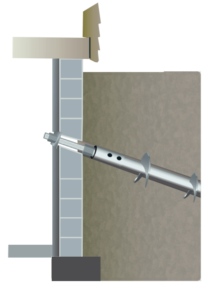
This is an illustration of helical tiebacks.
Tiebacks may still be an issue if you have something like an inground pool in this area. But there is one more option to consider.
There Is An Alternative Approach You Can Take
All of these repair options- carbon fiber straps, wall anchors, helical tiebacks -are stabilizing techniques. Installed correctly, Acculevel guarantees the wall won’t bow any farther. But if a basement wall is bowing significantly, you may not just want the wall stabilized. You may want it straightened, too.
How Do You Straighten A Bowing Foundation Wall?
Wall straightening is the most expensive option, because it requires significant time and labor. It’s also very messy, because we have to excavate outside the entire wall. Once there is no soil pushing against the foundation, it can be pushed back into position (from the inside of your basement).
When the wall is straightened, you will still need carbon fiber straps installed. Once a wall has cracked, it’s vulnerable to cracking again. Straps reinforce the wall, so that it’s no longer vulnerable to hydrostatic pressure.

This photo was taken by an Acculevel team member, while straightening a basement wall.
This is a very popular solution for homeowners who want to finish their basement. Generally, if you’re going to remodel an area as living space, you want all the walls to be plumb. Want to know more about the wall straightening process? Check out our case study, Home Renovation: Preparing to Finish A Basement.
Waterproofing May Be Necessary To Protect Your Foundation
Do you have an interior waterproofing system in your basement? If the answer to that is, “no,” it may be time to change that. This is especially true if water is a frequent intruder in your basement or causing damage to your foundation. If you are experiencing these problems, interior waterproofing is an excellent investment.
Waterproofing doesn’t keep your basement 100% dry; instead, it manages and controls any water that is trying to get into your basement. The water drainage system collects the water seeping in through the walls or floor, and directs it into a sump pump system. The sump pump then ejects the water through a discharge line.
Having a quality waterproofing system in your basement can relieve hydrostatic pressure; doing this can prevent water intrusion, foundation cracks, and even bowing walls. You can learn more about the ins and outs of basement waterproofing through our homeowner’s guide.
Our waterproofing guide answers all of the questions we are regularly asked by homeowners, explains the different types, how to know which type you need, what it costs, how installation is done, and more!
Have More Questions About The Symptoms You’ve Found?
We’ve introduced a lot of symptoms, industry terms, repair types, and repair products. You may feel a little overwhelmed. We may have answered your initial question, only to give you additional questions about our answer! Throughout this article, we’ve provided links to other resources for you to use, but we have another one to offer:
Our free diagnostic tool will help you pin down what problems you’re experiencing, and where to get more information on our learning center or our YouTube channel.
If You Need An In-Home Assessment Of Your Basement
You should find an experienced, well-established, and highly qualified foundation repair company to examine your house. If you live within our service area (Indiana and the surrounding areas), schedule an appointment with Acculevel!
One of our friendly and knowledgeable foundation experts will come to your home, meet with you to discuss your concerns, then evaluate your entire house. We look at more than just the foundation, because problems like sticking doors and cracked drywall can be found in other parts of your home.
Our goal is to provide you with a whole-home solution. This means we want to detect the symptoms you’ve identified, as well as the underlying cause(s). It’s not in your best interests for us to repair a crack, if we ignore what caused that crack. You’re just going to have the same problem again, and again. Instead, we want to eliminate both the cause and the symptoms.
As a team, you and your assigned project advisor will review the options and decide on the best plan for you and your family. We want to help you keep your home healthy and safe for years to come. Schedule your in-home assessment today; let us help you preserve and protect your home.
If you do not live in our part of the Midwest, please make sure you select a company that is properly insured and accredited by the Better Business Bureau. You can also use our guide to Questions to Ask a Contractor; this can help you screen potential contractors and protect yourself from potential con artists.
